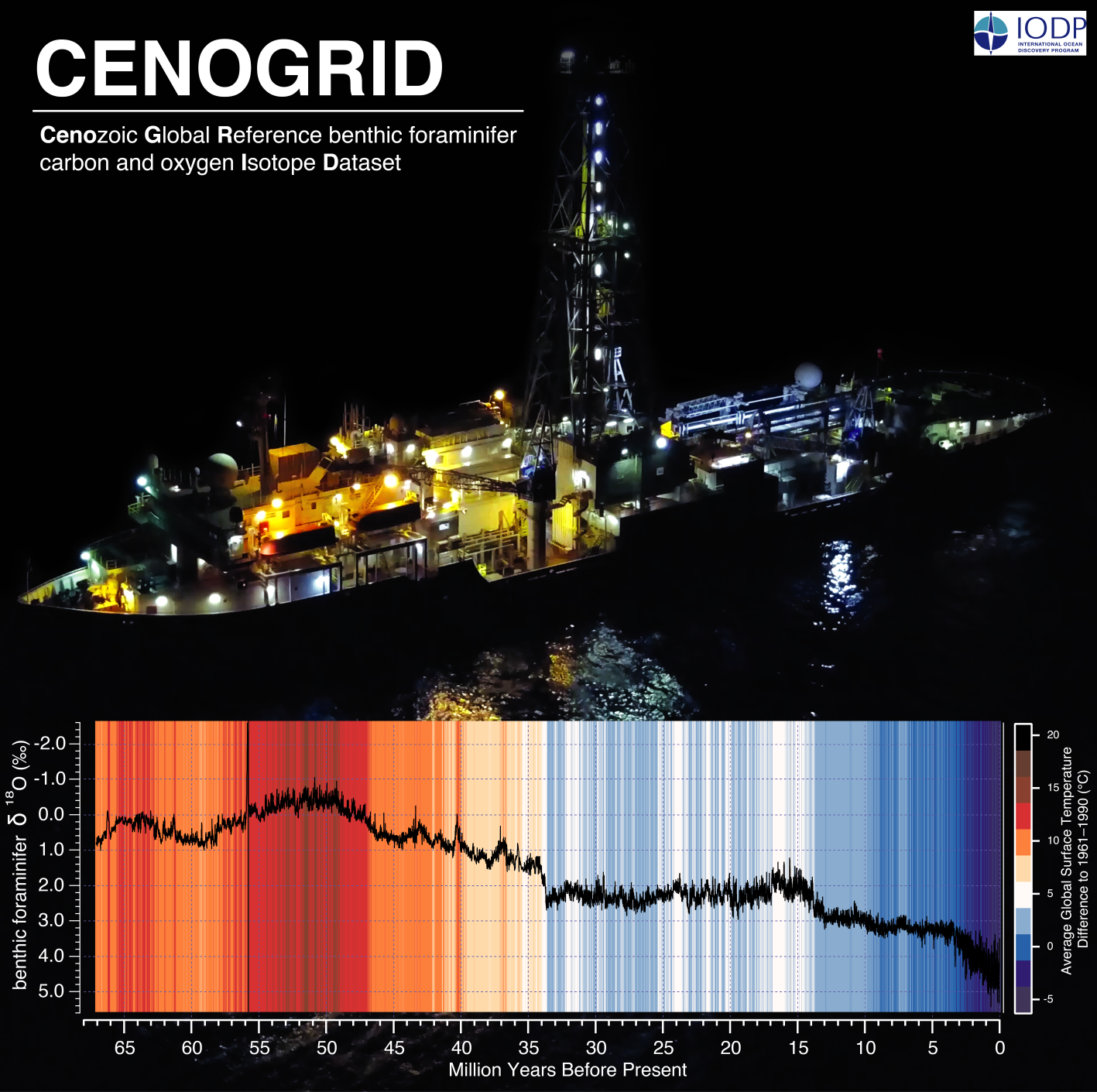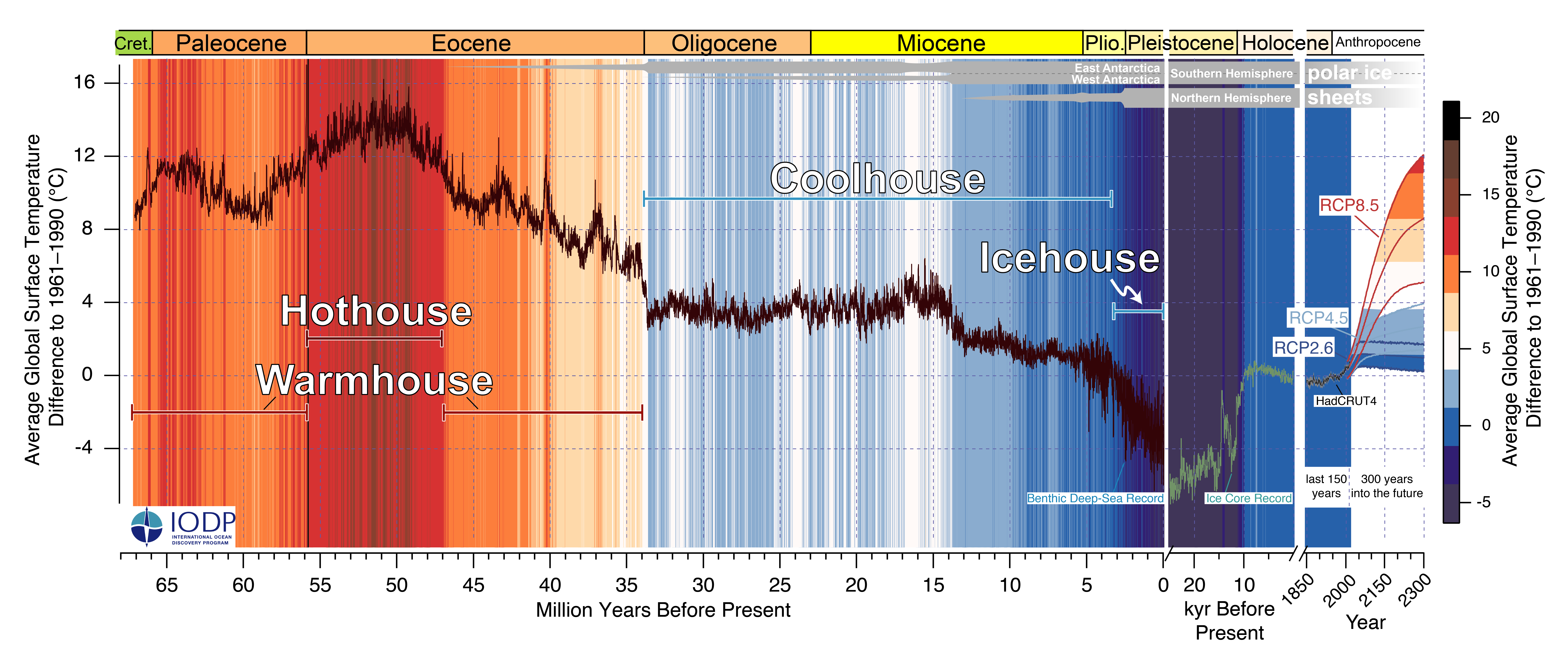Submitted by Administrator on Thu, 03/09/2020 - 13:27
Research published today in Science presents a new record of Earth’s temperature and glaciation since the end of the age of the dinosaurs, revealing the changing state of the climate system through the last 66 million years.
“Our goal was to create a new reference of past climate over the last 66 million years, which not only incorporates the highest-resolution data but is also more accurately dated,” explains Thomas Westerhold, who led the new study and is based MARUM Centre for Marine Environmental Sciences (University of Bremen). “Now we know, to a greater degree of accuracy, when it was warmer or colder in the past, and we also have a better understanding of the underlying dynamics behind these changes.”
The work is an international collaboration between marine scientists from twenty institutions, including Professor David Hodell at the Department of Earth Sciences, University of Cambridge.

The new Cenozoic climate curve (CENOGRID) overlain on hot / cold colour bands, indicating hothouse, warmhouse, coolhouse and coldhouse climate states. Temperature is inferred from the concentration of the stable oxygen isotope δ18O, an indicator of global ice volume. Although temperatures over millions of years appear to be dropping, current anthropogenic warming is happening at an unprecedented rate not seen during the Cenozoic. Image credit Thomas Westerhold / Adam Kutz.
Throughout the Cenozoic, the climate has slowly transitioned from a 'hothouse', when no continental glaciers exist on our planet, to an 'icehouse', a period when there were ice sheets on both poles.
According to Hodell, “the best evidence for these changes in Earth’s climate comes from sediment at the bottom of the ocean - these are some of the only continuous archives to extend back hundreds of millions of years.”
Some of the first records of Cenozoic climate change were produced by the late Sir Nicholas Shackleton in the Godwin Laboratory at Cambridge. Recent advances in ocean drilling techniques and statistical analysis have allowed the team to build a more detailed Cenozoic climate record, drawing carbon and oxygen isotope data from fourteen marine cores, collected as part of the International Ocean Discovery Program (IODP).
The team’s 66 million year-long record reveals a colourful barcode of changing climate states. “We can identify four key climate phases: hothouse, warmhouse, coolhouse and icehouse,” explains Norbert Marwan of the Postdam Institute for Climate Impact Research (PIK). "This classification has been known for some time, but now we are able to identify the fundamental states with statistical precision and reveal their characteristic dynamics.”
“The presence of polar ice also plays a critical role in determining how our climate responds to cyclical changes in Earth’s orbit”, says Hodell.
Statistical analysis of the record revealed the climate was more predictable during hot and warmhouse phases, but when ice was present at high latitudes the climate became more responsive to changes in Earth’s tilt, “leading to a more complex response that results in a less predictable climate during cool and coldhouse states”, says Westerhold.

Past and future trends in global mean temperature show we are entering a phase of unprecedented climate change. The new Cenozoic climate curve is placed alongside ice core records, which show the changing climate over the last 25,000 years and instrumental climate data from 1850 to the present day. The future projections of global temperature (RCP scenarios) are shown for illustration. Under a business as usual emissions scenario temperatures may be pushed towards the hothouse conditions last seen 55 million years ago. Image credit Thomas Westerhold.
“Our mathematical analyses revealed what is at first invisible in the sediment - the hidden relationships and recurring patterns in the climate,” says Marwan. “From the slow natural climate fluctuations occurring over millions of years we can learn something about the staggeringly rapid anthropogenic changes of our present century.”
According to Hodell, “Earth’s climate has fluctuated dramatically on scales of millions of years, but we are entering a new and uncertain phase, with rising anthropogenic greenhouse emissions and shrinking ice sheets. The current rates of change are unprecedented compared to the long-term history of Cenozoic climate”.
Westerhold et al. 'An astronomically dated record of Earth’s climate and its predictability over the last 66 Million Years' Science (2020). DOI: 10.1126/science.aba6853.
